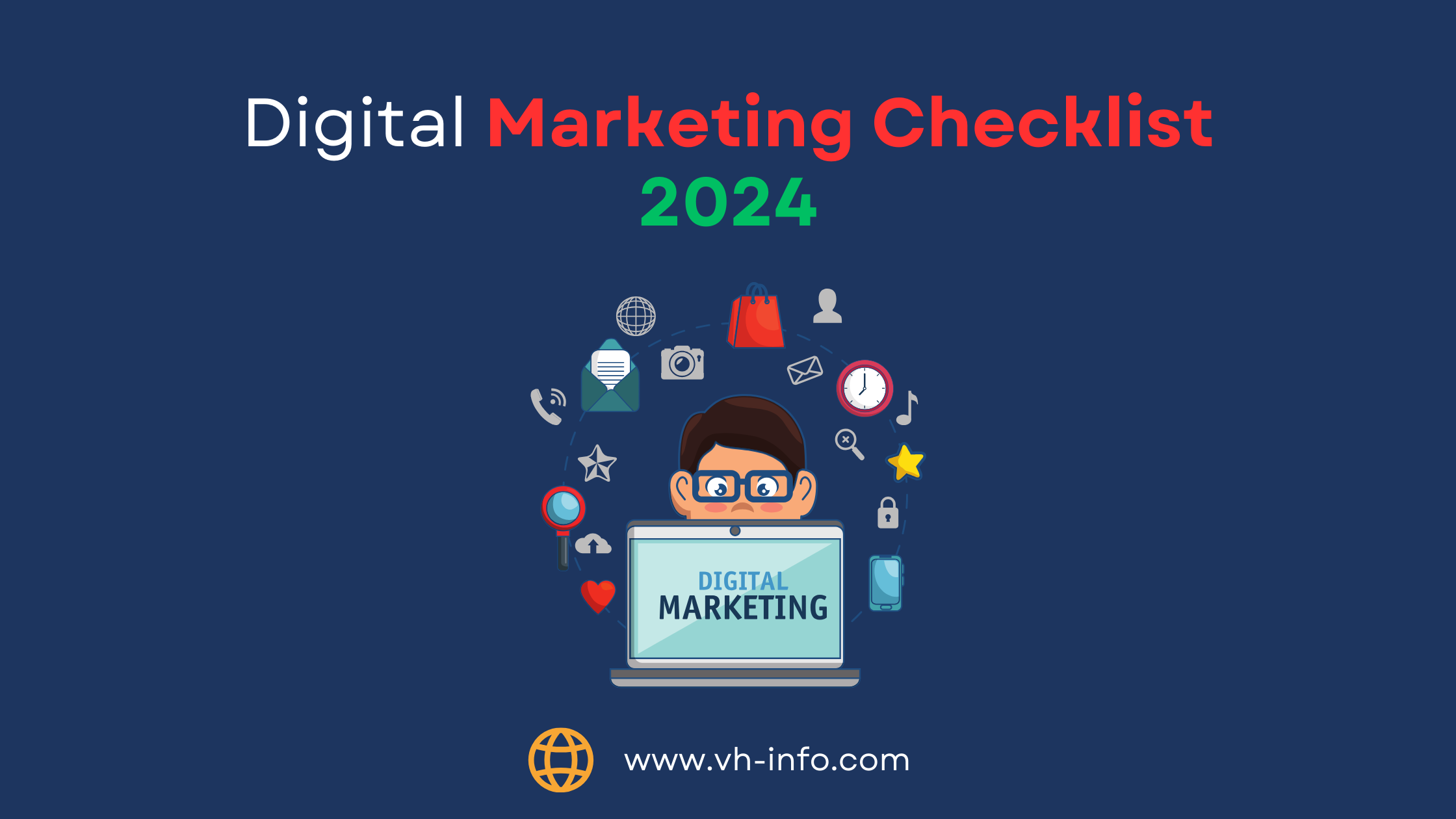What is Digital Marketing ?

Digital marketing concept refers to the use and management of digital channels, platforms, and technologies to promote our product and brand and advertise products, services, or brands to a targeted audience by using macro or micro marketing techniques. It encompasses a broad range of online marketing activities that leverage digital channels such as search engines, social media, instant messaging channels, email, websites, and other digital platforms.
Select Marketing Channels for 2024

Potential digital marketing channels that were gaining prominence. However, keep in mind that the digital marketing landscape is big, dynamic, and trends may evolve. Here are some marketing checklist that were significant and might continue to be relevant in 2024:
Top Digital Marketing Checklist essentials All Business.
1. SEO Checklist
The SEO checklist plays a pivotal role in boosting online visibility, ensuring that your business ranks prominently on search engine results pages. A comprehensive approach to SEO involves optimizing the basics, fine-tuning technical aspects, enhancing off-page strategies, and refining on-page content. In fact, studies show that businesses that invest in SEO efforts are 57% more likely to witness a significant increase in web traffic and customer acquisition. By focusing on elements such as keyword optimization, meta tags, backlink quality, and user-friendly website structures, businesses can harness the power of SEO to not only climb search rankings but also to enhance overall user experience. As the digital landscape evolves, integrating these SEO best practices becomes indispensable for maintaining a competitive edge and ensuring sustained growth in online visibility.
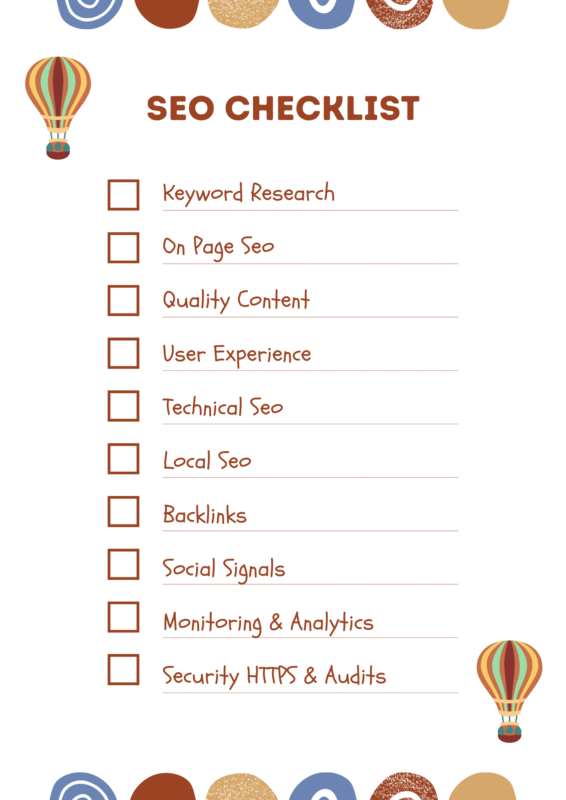
Keyword Research:
- Identify relevant keywords related to your business, products, or services.
- Use tools like Google Keyword Planner, SEMrush, or Ahrefs to discover high-potential keywords.
On-Page SEO:
- Optimize meta titles and descriptions with target keywords.
- Ensure each page has a clear and relevant URL structure.
- Use header tags (H1, H2, H3) to structure your content.
- Include keywords naturally in your content.
Quality Content:
- Create high-quality, valuable, and relevant content for your target audience.
- Aim for comprehensive, well-researched content that answers user queries.
- Regularly update and refresh content to keep it current.
User Experience (UX):
- Ensure your website is mobile-friendly and responsive.
- Improve site navigation for a positive user experience.
- Optimize page loading speed using tools like Google PageSpeed Insights.
Technical SEO:
- Create and submit a sitemap to search engines.
- Optimize crawl budget by fixing crawl errors and broken links.
- Implement schema markup to enhance rich snippets in search results.
- Optimize images by compressing them without sacrificing quality.
Local SEO:
- Claim and optimize your Google My Business listing.
- Ensure accurate and consistent NAP (Name, Address, Phone Number) information across online platforms.
- Encourage positive online reviews from satisfied customers.
Backlinks:
- Build high-quality backlinks from reputable and relevant websites.
- Avoid low-quality or spammy backlinks that can harm your SEO.
Social Signals:
- Maintain an active presence on social media platforms.
- Share and promote your content on social channels to increase visibility.
Monitoring and Analytics:
- Set up Google Analytics and Google Search Console for monitoring website performance.
- Track key SEO metrics such as organic traffic, bounce rate, and keyword rankings.
Security (HTTPS):
- Ensure your website uses a secure, HTTPS connection.
- Google tends to favor secure websites in search results.
Regular Audits and Updates:
- Conduct regular SEO audits to identify and fix issues.
- Stay informed about algorithm updates and adjust your strategy accordingly.
2. Social Media Marketing Checklist
Social Media Marketing is a dynamic and essential component of a comprehensive digital marketing strategy. In 2024, with over 4.2 billion active social media users worldwide, a well-executed Social Media Marketing Checklist is imperative for businesses aiming to connect with their target audience effectively. Creating and optimizing business profiles on platforms like Facebook, Instagram, Twitter, and LinkedIn is the first step. Publishing regular updates and maintaining a consistent posting schedule is crucial, as 79% of internet users have at least one social media account, emphasizing the vast reach of these platforms.
Crafting a strategic Social Media Marketing plan, including content calendars and engagement strategies, becomes paramount. With the average person spending approximately 2 hours and 31 minutes on social media daily, maximizing follower engagement through polls, questions, and contests further boosts brand visibility. Ultimately, businesses can leverage the power of social media to foster meaningful connections and drive business growth.
Creating a comprehensive social media marketing checklist is crucial for building and maintaining a strong presence on social platforms. Here’s a checklist to guide your social media marketing efforts:
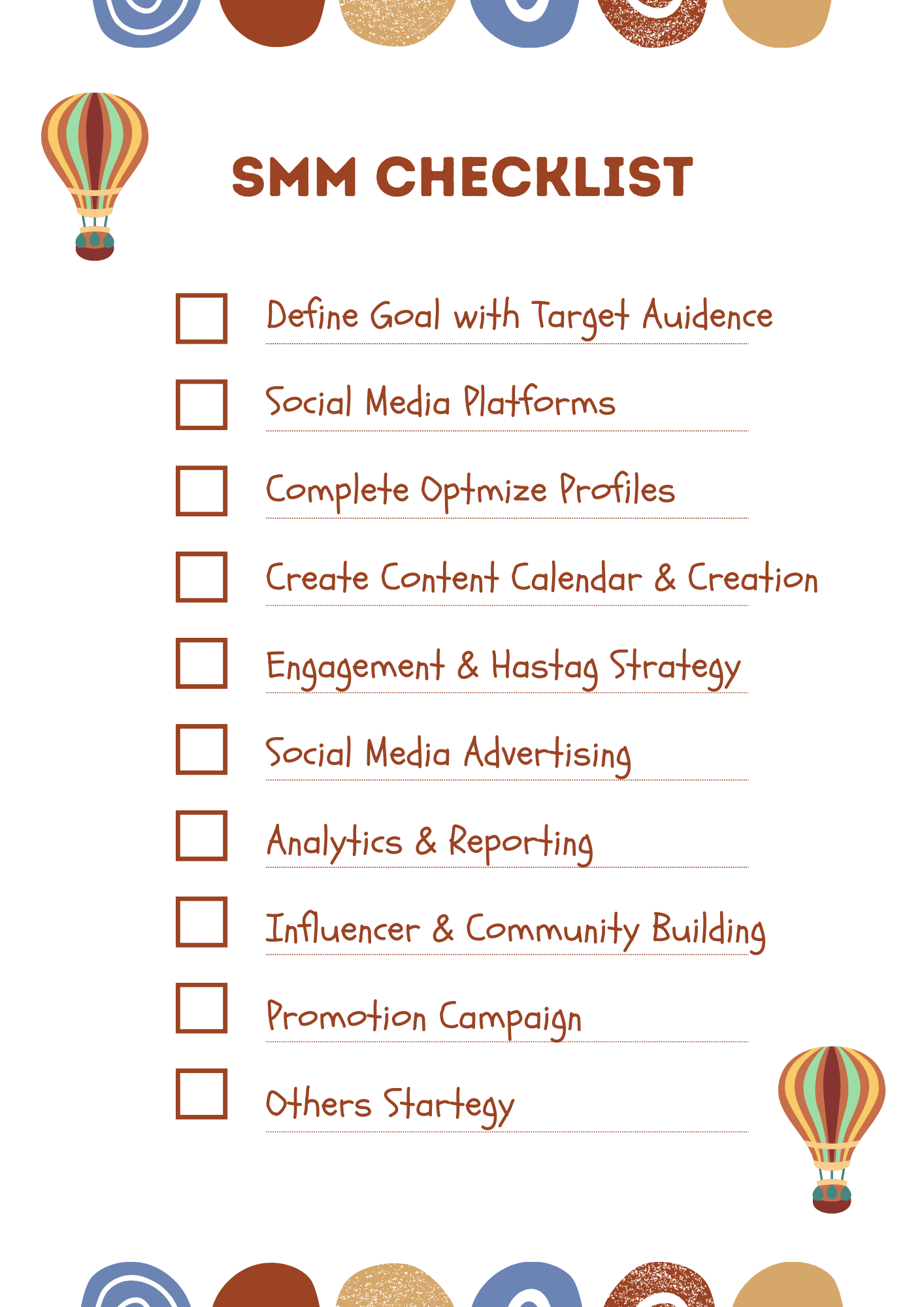
Define Goals and Objectives:
- Clearly outline your social media marketing goals.
- Ensure that your goals align with your overall business objectives.
Target Audience Identification:
- Define your target audience demographics and interests.
- Tailor your content and messaging to resonate with your audience.
Choose Relevant Social Platforms:
- Identify the social media platforms where your target audience is most active.
- checkout platforms such as Facebook, Instagram, Twitter, LinkedIn, Pinterest, or TikTok.
Complete and Optimize Profiles:
- Ensure your profiles are complete with accurate business information.
- Use high-quality profile and cover images.
- Include relevant keywords in your profile descriptions.
Create a Content Calendar:
- Plan your social media content in advance using a content calendar.
- Maintain a consistent posting schedule to keep your audience engaged.
Content Creation and Curation:
- Develop a mix of content types, including images, videos, infographics, online events and text posts.
- Curate and share relevant content from other sources to provide value to your audience.
Engagement and Interaction:
- Respond promptly to comments, messages, and mentions.
- Encourage audience engagement through polls, questions, and contests.
Hashtag Strategy:
- Use relevant and trending hashtags to increase the discoverability of your content.
- Create branded hashtags for campaigns or promotions.
Social Media Advertising:
- Consider paid advertising options on platforms like Facebook Ads, Instagram Ads, or LinkedIn Ads.
- Set clear objectives for your paid campaigns, whether it’s brand awareness, lead generation, or conversions.
Analytics and Reporting:
- Utilize analytics tools provided by each platform (e.g., Facebook Insights, Twitter Analytics) to track performance.
- Monitor key metrics, including engagement, reach, clicks, and conversions.
Social Media Strategy Review:
- Regularly assess your social media strategy’s effectiveness.
- Adjust your approach based on analytics and feedback.
Influencer Collaboration:
- Identify and collaborate with influencers relevant to your industry or niche.
- Leverage influencer partnerships to reach a broader audience.
Community Building:
- Foster a sense of community among your followers.
- Encourage user-generated content and testimonials.
Promotions and Campaigns:
- Plan and execute social media promotions or campaigns.
- Leverage special events or holidays for themed campaigns.
Stay Informed About Trends:
- Stay updated on the latest social media trends and algorithm changes.
- Adapt your strategy to align with evolving platform features.
Evaluate and Adjust Strategy:
- Regularly evaluate the performance of your social media marketing efforts.
- Adjust your strategy based on what works best for your audience.
3. Content Marketing Checklist

Content marketing is a vital component of any successful digital strategy, requiring careful planning and execution. The Content Marketing Checklist encompasses crucial steps to engage and resonate with target audiences. Identifying your audience’s demographics and preferences is key; in fact, according to HubSpot, businesses that prioritize blogging are 15 times more likely to achieve a positive return on investment. Aligning content with the customer journey ensures relevance, and a well-crafted plan can significantly impact results.
Research from the Content Marketing Institute indicates that having a documented content strategy not only increases overall content marketing success but also helps teams work more efficiently. Publishing content based on real data and analysis adds authenticity and builds trust with your audience. Therefore, it’s essential to continually refine your approach, staying agile in response to industry trends and consumer feedback.
Define Your Content Marketing Goals:
- Clearly outline your content marketing objectives.
- Align your goals with overall business and marketing objectives.
Target Audience Identification:
- Develop detailed buyer personas.
- Understand the needs, preferences, and pain points of your target audience.
Keyword Research:
- Identify relevant keywords for your industry and audience.
- Use tools like Google Keyword Planner, SEMrush, or Ahrefs.
Content Calendar Creation:
- Develop a content calendar for planning and scheduling.
- Ensure consistency in publishing to maintain audience engagement.
- Stay up to date with current events and topical awareness days.
Measurement and Analytics:
- Use analytics tools to track content performance.
- Monitor metrics such as website traffic, engagement, and conversions.
Repurposing Content:
- Repurpose successful content into different formats (e.g., turning a blog post into a video).
- Extend the lifespan of valuable content through updates.
Audience Engagement and Interaction:
- Encourage comments, shares, and discussions around your content.
- Respond promptly to audience feedback.
Brand Consistency:
- Maintain a consistent brand voice and style across all content.
- Ensure visual consistency with branded images and graphics.
Competitor Analysis:
- Analyze competitor content strategies.
- Identify content gaps and opportunities within your industry.
Continuous Improvement:
- Seek feedback from your audience.
- Use insights to continually refine and improve your content strategy.
4. Website Marketing Checklist
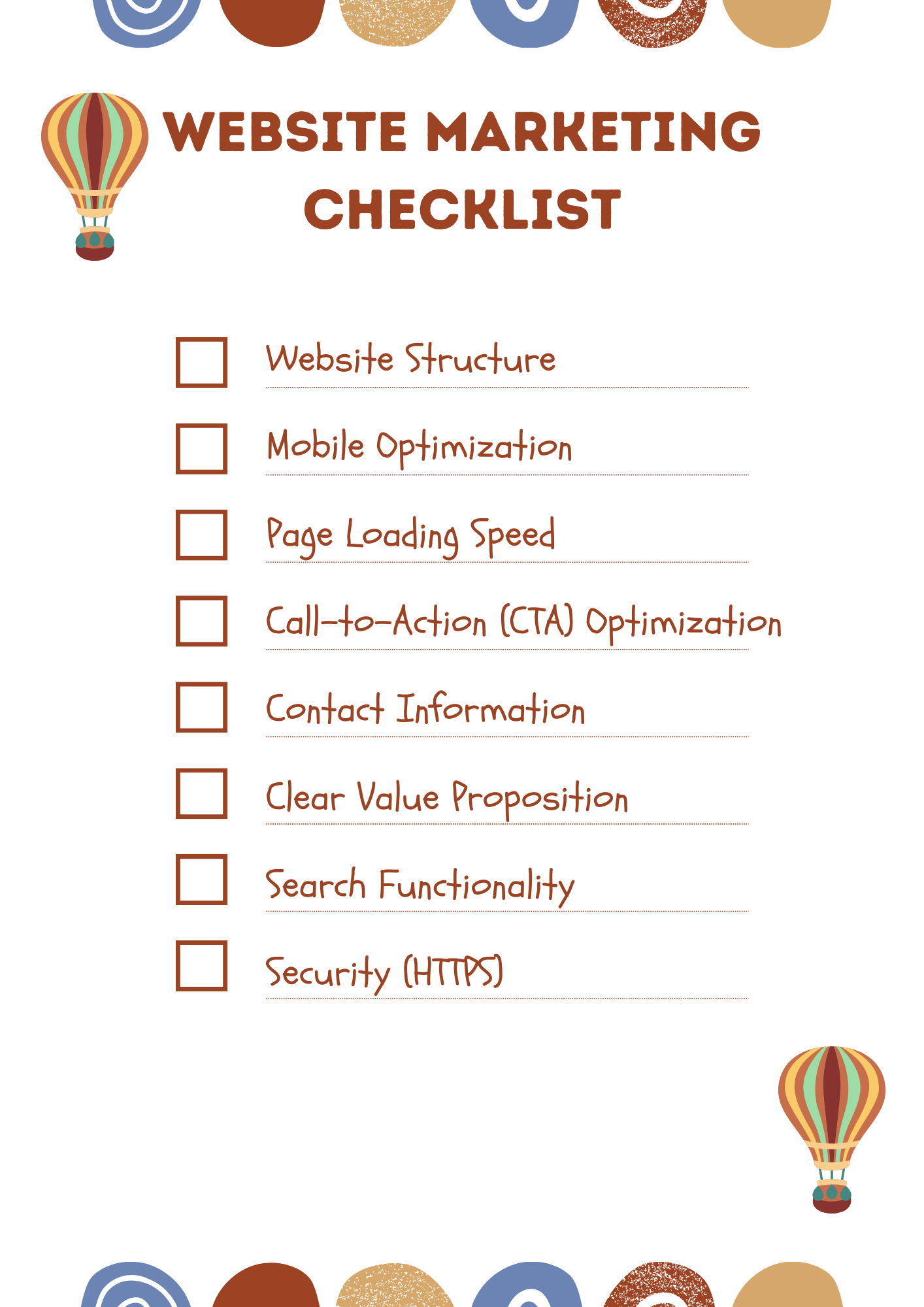
An effective website content plan is paramount for cultivating a thriving online presence. The cornerstone of this plan is the Website Marketing Checklist, a vital instrument in ensuring that your digital platform is finely tuned to achieve optimal performance. According to recent studies, 91% of consumers cite website design as the reason they mistrust or reject a website. To counter this, focus on optimizing the website structure for intuitive navigation, ensuring seamless experiences on both desktop and mobile platforms. Regularly evaluate performance metrics, as 41% of users expect a website to load in two seconds or less. Incorporate strategic SEO elements, such as meta titles, descriptions, and schema markup, to enhance search engine visibility. By meticulously adhering to this checklist, businesses can fortify their online presence, meet user expectations, and ultimately drive engagement and conversions.
Website Structure:
- Ensure a clear and user-friendly navigation structure.
- Optimize the layout for easy navigation on both desktop and mobile devices.
Mobile Optimization:
- Confirm that your website is mobile-responsive.
- Test your website on various devices to ensure a seamless mobile experience.
Page Loading Speed:
- Optimize images and multimedia elements for faster loading times.
- Use tools like Google PageSpeed Insights to identify and address speed issues.
Call-to-Action (CTA) Optimization:
- Place clear and compelling CTAs on relevant pages.
- Ensure CTAs stand out visually and are easily clickable.
Contact Information:
- Display accurate contact information prominently.
- Include a contact form for easy inquiries.
Clear Value Proposition:
- Clearly communicate your brand’s value proposition.
- Highlight key benefits and unique selling points.
Search Functionality:
- Implement a search bar for easy navigation.
- Ensure the search function provides relevant results.
Security (HTTPS):
- Ensure your website uses a secure, HTTPS connection.
- Obtain an SSL certificate to encrypt data.
- Employ the benefits of VPN services to enhance HTTPS security, providing extra encryption for data transmission, especially useful for users accessing your site from diverse networks.
5. Advertise Marketing Checklist

In the dynamic landscape of digital advertising, a well-structured Advertise Marketing Checklist serves as the compass guiding businesses towards optimal campaign performance. According to a recent survey, digital ad spending is projected to reach $402 billion by the end of 2024, emphasizing the increasing significance of effective advertising strategies.
To harness the full potential of paid campaigns, businesses should explore diverse advertising platforms, strategically allocate budgets, and meticulously optimize through A/B testing. The data-driven approach, crucial in today’s competitive environment, involves constant monitoring of key metrics like click-through rates and conversion rates.
Crafting compelling ad copy and visuals is paramount, ensuring the content resonates with the target audience. Regular review and adaptation of ad strategies based on analytics not only enhance brand visibility but also contribute significantly to return on investment (ROI). In a world where attention spans are fleeting, a well-executed Advertise Marketing Checklist is the linchpin for capturing the audience’s attention and driving meaningful engagement.
Define Advertising Goals:
- Clearly outline the objectives of your advertising campaign (e.g., brand awareness, lead generation, conversions).
Understand Target Audience:
- Identify and understand your target audience.
- Tailor your ad content and targeting to match audience demographics and interests.
Budget Planning:
- Set a realistic and well-defined advertising budget.
- Allocate budgets across different channels or campaigns based on priorities.
Choose Advertising Platforms:
- Research and select the most effective advertising platforms for your business (e.g., Google Ads, Facebook Ads, Instagram Ads, LinkedIn Ads).
- Consider the preferences and behaviors of your target audience.
Ad Creative Development:
- Create compelling ad copy that aligns with your goals and resonates with your audience.
- Design visually appealing graphics or videos that capture attention.
Ad Format Selection:
- Choose the appropriate ad formats for each platform (e.g., display ads, search ads, video ads).
- Tailor ad formats to match the preferences of your target audience.
Landing Page Optimization:
- Ensure that the landing page linked in your ads provides a seamless and relevant user experience.
- Optimize landing pages for conversions.
A/B Testing:
- Conduct A/B testing for various elements of your ads (e.g., headlines, images, call-to-action buttons).
- Use insights to refine and optimize ad performance.
Ad Schedule Planning:
- Determine the optimal times and days to run your ads based on audience behavior.
- Adjust ad schedules to maximize reach and engagement.
Ad Tracking and Analytics:
- Implement tracking pixels or tags for accurate campaign measurement.
- Regularly review analytics data to assess campaign performance.
Conversion Tracking:
- Set up conversion tracking to measure the success of your campaigns.
- Attribute conversions to specific ads or campaigns.
6. Email Marketing Checklist
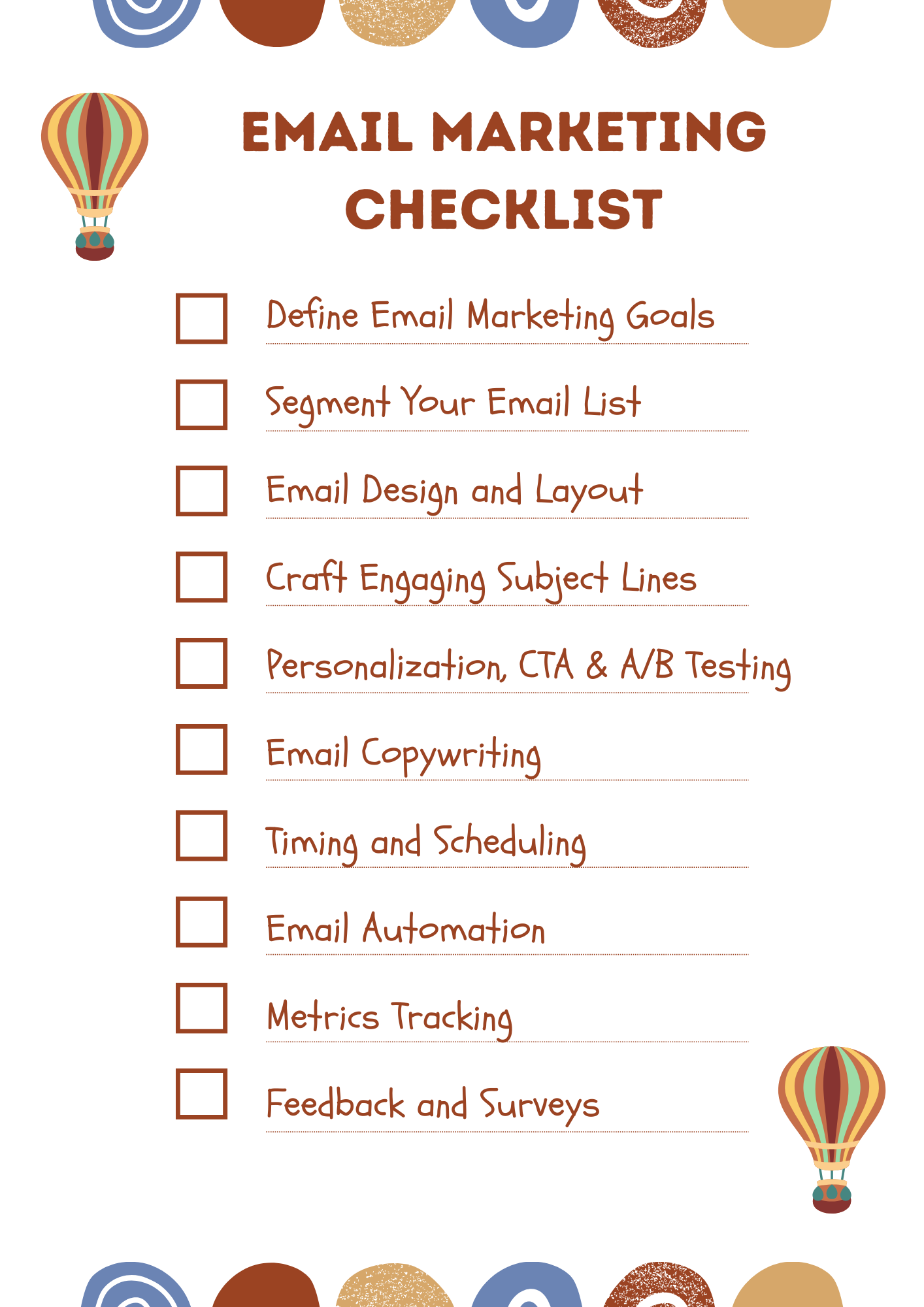
Email marketing remains a potent tool for businesses to engage and convert their audience. A well-executed email marketing strategy involves meticulous planning and execution. Start by defining clear goals for your campaigns, be it boosting sales or nurturing leads. Segment your audience to deliver personalized content, a strategy that has shown to increase revenue by 790%. Craft compelling subject lines, as 49% of recipients decide whether to open an email based on this factor alone .
Ensure mobile responsiveness, as mobile devices contribute to 51% of all email opens. Leverage automation to streamline processes and trigger emails based on user behavior, leading to a 16.31% increase in email marketing revenue. Regularly analyze key metrics such as open rates, click-through rates, and conversion rates, adjusting your email campaign management strategy accordingly. By incorporating these elements into your email marketing checklist, you can optimize campaigns for maximum impact and engagement.
Define Email Marketing Goals:
- Clearly outline the objectives of your email marketing campaign (e.g., lead generation, customer retention, sales conversion).
Segment Your Email List:
- Divide your email list into segments based on demographics, behaviors, or engagement levels.
- Personalize email content for each segment.
Email Design and Layout:
- Design visually appealing and mobile-responsive email templates.
- Use clear and compelling visuals with a balance of text.
Craft Engaging Subject Lines:
- Write attention-grabbing and relevant subject lines.
- Avoid spam-triggering words and misleading content.
Personalization:
- Include personalization elements such as recipient names or personalized product recommendations.
- Use dynamic content based on subscriber preferences.
Clear Call-to-Action (CTA):
- Include a clear and compelling CTA in each email.
- Make sure the CTA stands out and leads to a relevant landing page.
A/B Testing:
- Conduct A/B tests for different elements, such as subject lines, content, or CTA buttons.
- Analyze results to optimize future campaigns.
Email Copywriting:
- Write concise and engaging email copy.
- Focus on the value proposition and benefits for the recipient.
Timing and Scheduling:
- Determine the optimal timing for sending emails based on your audience’s behavior.
- Test different send times to identify peak engagement periods.
Avoid Spam Triggers:
- Ensure your emails comply with anti-spam regulations.
- Avoid using spam-triggering words and phrases in your content.
Permission Marketing:
- Only send emails to subscribers who have given explicit consent.
- Include an unsubscribe option in every email.
List Cleaning:
- Regularly clean your email list by removing inactive or bounced email addresses.
- Maintain a healthy and engaged subscriber base.
Email Automation:
- Implement automation for welcome emails, drip campaigns, and follow-ups.
- Set up triggered emails based on user behavior.
Metrics Tracking:
- Track key metrics such as open rates, click-through rates, and conversion rates.
- Analyze data to measure the success of your campaigns.
Feedback and Surveys:
- Encourage feedback from your subscribers.
- Conduct surveys to gather insights for improvement.
7. Video Marketing Checklist

In the realm of digital marketing, a well-executed video marketing strategy is a powerful tool for engaging audiences and driving brand success. The Video Marketing technique is a comprehensive guide to crafting compelling visual content. According to a recent study by HubSpot, incorporating videos in marketing efforts increases user understanding of a product or service by 74%. According to a survey 70% B2B marketers use video marketing, while 65% are B2C and expected reach of customers / users are 91%.
To begin, set clear goals for your videos, identifying the target audience and tailoring content to resonate with their preferences. A compelling script and storyboard lay the foundation, while high-quality production equipment ensures a professional look and feel. Utilize trackable affiliate links to measure attribution accurately. Once the video is ready, optimize its visibility with SEO techniques, including keyword-rich titles and descriptions. Leverage social media platforms for distribution and engage with your audience through comments and shares. Regularly analyze video analytics to refine future content. By following this checklist, you can harness the immense potential of video marketing, driving higher engagement and conversion rates for your brand.
Define Video Marketing Goals:
- Clearly outline the objectives of your video marketing campaign (e.g., brand awareness, lead generation, engagement).
Identify Target Audience:
- Understand your target audience’s demographics, interests, and preferences.
- Tailor video content to resonate with your audience.
Content Planning:
- Plan your video content creation that aligns with your marketing goals.
- Consider different types of videos (explainer, tutorial, testimonial, etc.).
Scriptwriting:
- Develop a compelling script that communicates your message effectively.
- Ensure a clear and engaging narrative structure.
Storyboarding:
- Create a visual storyboard to outline the flow of the video.
- Include key scenes, shots, and transitions.
Video Production Equipment:
- Use high-quality video production equipment (camera, lighting, audio).
- Consider hiring professionals for complex video productions.
Set Design and Location:
- Plan and set up the environment for filming.
- Ensure the setting complements your brand and message.
Filming and Editing:
- Capture high-quality footage with proper lighting and sound.
- Edit the video for a polished and professional look.
Branding Elements:
- Incorporate consistent branding elements such as logos and colors.
- Maintain brand consistency across all video content.
Optimize Video Length:
- Consider the attention span of your audience.
- Aim for a video length that conveys your message without losing viewer interest.
Call-to-Action (CTA):
- Include a clear and compelling CTA within the video.
- Guide viewers on the desired next steps.
Transitions and Animations:
- Use smooth transitions and animations for visual appeal.
- Avoid excessive effects that may distract from the message.
Music and Audio:
- Incorporate background music that enhances the video’s mood.
- Ensure clear and high-quality audio for voice overs or dialogue.
Engagement and Interaction:
- Encourage viewer engagement through comments, likes, and shares.
- Respond to audience comments to build a community.
Video Analytics:
- Use video analytics tools to track performance metrics.
- Analyze data on views, engagement, and conversion rates.
Feedback and Iteration:
- Gather feedback from viewers and stakeholders.
- Use insights to iterate and improve future video content.
Stay Updated on Video Trends:
- Stay informed about evolving video trends and formats.
- Experiment with new techniques to keep your content fresh.
8. Affiliate Marketing Checklist

It serves a strategic roadmap for businesses aiming to leverage the power of affiliate partnerships. This concise yet comprehensive guide outlines key steps to initiate and manage a successful affiliate marketing program. It begins by clearly defining goals and selecting an appropriate affiliate platform.
This marketing checklist emphasizes the importance of creating transparent program terms, setting competitive commission structures, and identifying target affiliates. Providing a suite of marketing materials, facilitating an efficient onboarding process, and implementing trackable affiliate links are crucial steps for seamless collaboration.
Below checklist also highlights ongoing communication, support, and performance incentives to foster a mutually beneficial relationship. By staying vigilant about compliance, regularly evaluating program performance, and adapting strategies to industry trends, businesses can unlock the full potential of affiliate marketing, driving brand growth and customer acquisition.
Define Affiliate Marketing Goals:
- Clearly outline the objectives of your affiliate marketing program (e.g., sales, leads, brand exposure).
Choose an Affiliate Platform:
- Select an affiliate marketing platform or software to manage your program.
- Consider platforms such as ShareASale, CJ Affiliate, or others.
Create Affiliate Program Terms:
- Develop clear and transparent terms and conditions for affiliates.
- Include details on commission rates, payment schedules, and promotional guidelines.
Set Commission Structure:
- Determine the commission structure for affiliates (e.g., percentage of sales, fixed amount per lead).
- Consider tiered structures for higher-performing affiliates.
Identify Target Affiliates:
- Define your ideal affiliate partners.
- Reach out to influencers, bloggers, or industry experts who align with your brand.
Provide Marketing Materials:
- Create a variety of promotional materials for affiliates (banners, product images, text links).
- Ensure that these materials align with your brand identity.
Trackable Affiliate Links:
- Implement trackable affiliate links for accurate attribution.
- Use unique identifiers for each affiliate.
Feedback Collection:
- Collect feedback from affiliates on the program.
- Use insights to make continuous improvements.
Stay Updated on Industry Trends:
- Stay informed about evolving trends in affiliate marketing.
- Adapt your program to incorporate new strategies and technologies.
FAQs
Q1. Do I need all the tools you mentioned in the checklist?
Ans: Not necessarily! This checklist is a comprehensive guide, but the right tools depend on your specific marketing goals and budget. Start by identifying your most critical areas of focus (e.g., social media, SEO, email marketing) and prioritize tools that support those needs. Remember, quality beats quantity – choose tools you can utilize effectively and integrate seamlessly into your workflow.
Q2. I’m just starting with digital marketing. Where do I even begin?
Ans: Don’t get overwhelmed! Focus on building a strong foundation. Start with establishing your brand identity, defining your target audience, and creating a website that accurately reflects your brand and value proposition. Then, choose 1-2 core channels like social media or email marketing and invest in learning the basics and establishing your presence there. Gradually, you can expand to other channels and tools as you become more comfortable.
Q3. I’m on a tight budget. Can I still implement a successful digital marketing strategy?
Ans: Absolutely! Many free and affordable tools can help you launch and grow your digital marketing efforts. Platforms like Canva, Hootsuite, and Mailchimp offer robust free plans with valuable features. Utilize Google Analytics and Search Console for website insights, explore organic social media reach before jumping into paid campaigns, and leverage free community resources for learning and support.
Q4. How often should I update my digital marketing checklist and strategy?
Ans: The digital landscape evolves rapidly, so regular updates are key. Aim to revisit your checklist every quarter or semester to adjust to trends, platform changes, and evolving audience behavior. This might involve tweaking your content types, optimizing your website for current search algorithms, or trying new tools and strategies. Don’t be afraid to experiment and adapt to stay ahead of the curve!
Conclusion
Successful digital marketing in 2024 requires a holistic and integrated approach. Regularly assess and adapt your strategies based on evolving trends, technological advancements, and performance metrics. Stay informed, engage with your audience, and consistently deliver value to build a strong online presence.
Implementing and consistently revisiting these checklists will contribute to a robust digital marketing strategy that aligns with your business goals and keeps you ahead in the ever-changing digital landscape of 2024.

